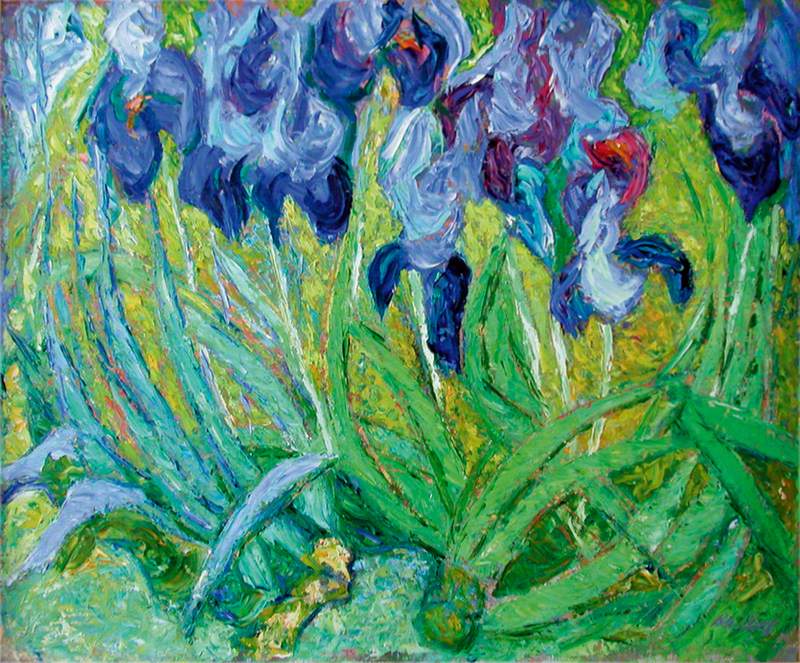
“Research Reveals Vincent van Gogh’s Famous Blue ‘Irises’ Were Previously Purple”

# The Vibrant Transformation of Vincent van Gogh’s *Irises*: Insights from the Getty Museum
Few artistic creations enthrall viewers like Vincent van Gogh’s 1889 jewel, *Irises*. This painting, celebrated for its lively blue petals and energetic structure, has long been considered a reflection of Van Gogh’s remarkable skill in using color to evoke feelings of serenity and emotion. Nevertheless, recent pioneering research at the Getty Museum has revealed a captivating twist: the legendary flowers were initially a brilliant purple. This discovery has ignited renewed admiration for the piece and provided surprising perspectives on the connection between art, science, and the passage of time.
## A Masterpiece Reexamined During an Unparalleled Pandemic Hiatus
The J. Paul Getty Museum obtained *Irises* in 1990, securing its status as a major highlight of the collection. Since that time, the artwork has been almost continuously on display, complicating opportunities for in-depth study. However, the museum’s temporary closure during the COVID-19 pandemic provided conservators and researchers an exceptional occasion to analyze *Irises* closely in their workshop.
Their results, now featured in a new exhibit titled *Ultra-Violet: New Light on Van Gogh’s Irises*, illustrate how contemporary science reveals Van Gogh’s artistic techniques and the natural deterioration processes that have transformed the painting over the centuries.
## Concealed in Plain Sight: Discovering Van Gogh’s Color Palette
One pivotal revelation by the Getty’s research group is that the blue blossoms we observe now were formerly a vivid purple. Interestingly, Van Gogh himself alluded to this in a correspondence with his brother Theo, mentioning the artwork as containing “violet irises.” Researchers have confirmed this hypothesis utilizing cutting-edge analytical methods, including X-ray fluorescence (XRF) spectroscopy, which detected indicators of a light-sensitive red pigment known as *geranium lake*. When combined with blue pigment, geranium lake would have produced the striking purple tone Van Gogh originally envisioned.
Regrettably, geranium lake has a reputation for being unstable. As time passed, extended exposure to light caused the red pigment to fade markedly, resulting in the predominance of blue hues we observe today. Notably, Van Gogh and numerous contemporaries knew of these pigments’ limitations yet opted to utilize them, motivated by their vibrant and expressive qualities.
## Science Illuminates the Past
Through non-invasive methods and digitalization, the Getty team has crafted a digital reimagining of *Irises* that approximates what the painting might have looked like in 1889. This technology-enhanced reinterpretation highlights the original purple shades of the flowers, giving viewers a chance to peek into Van Gogh’s artistic aspirations as he perceived them over 130 years ago.
These revelations go beyond mere color. During their investigations, scientists also stumbled upon an intriguing detail embedded within the paint: a pollen cone. This finding supports long-held speculation that Van Gogh created *Irises* *en plein air* (outdoors), further underlining his profound connection to the natural world.
## Merging Art and Science: A Collaborative Endeavor
*Irises* exemplifies how contemporary science and classical art history can coalesce to enhance our comprehension of historic artworks. Through meticulous examination and evolving technologies, researchers succeeded in unraveling the intricate layers of Van Gogh’s artistic decisions, materials, and methods.
Central to the exhibit is not only the digital restoration of the artwork but also several related items that place Van Gogh’s process in context. These comprise a replica of the red lacquered box he utilized to experiment with colors using spools of yarn, as well as the original letter in which he recounted his ongoing efforts on *Irises*. These artifacts, on loan from the Van Gogh Museum in Amsterdam, enrich the story surrounding the painting.
## Van Gogh’s Legacy: An Ongoing Journey of Discovery
This newfound insight into *Irises* serves as a poignant reminder of the impermanence of art and the significant role that modern technology plays in its preservation and interpretation. While the transformations in *Irises* signify a fascinating nexus of chemistry and art, they also raise broader inquiries about how time and natural phenomena influence iconic works.
Timothy Potts, the Getty Museum’s director, emphasizes the lasting importance of these discoveries: “Art conservation exemplifies the intersection of science and art, merging art history with scientific exploration. This exhibition highlights the enlightening outcomes of such studies.”
## Contemplating Van Gogh’s Lasting Influence
Van Gogh’s *Irises* continues to be one of his most cherished creations, not just for its aesthetic allure but also for the subtle poignancy it expresses. Painted during the artist’s residence at the Saint-Paul-de-Mausole asylum in Saint-Rémy-de-Provence—just a year prior to his tragic demise—it stands as a vivid testament to both his prowess and turbulent emotional landscape.
The recent revelations about its purple heritage bring us closer to grasping Van Gogh’s intentions and his unwavering passion.